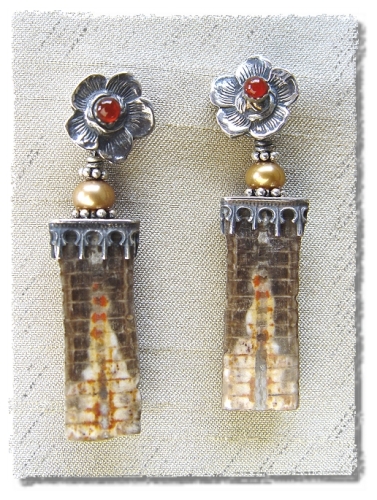Crinoid Cat Earrings

My friend Judith took one look at these earrings and said, "kitties!" Somehow I had failed to notice the long,
elegant cats staring out of these stones. I also failed to ask Falk how old these fossils are and where they
came from. If you've been to the Tucson gem
shows perhaps you will sympathize with the overload condition one finds oneself in. At any rate, these are fossil
members of the "sea lily" group of sea animals which still exist today as feather stars and comatulids despite a few mass
extinctions along the way. Crinoids formed such dense aggregations that their skeletons are today the main constituents
of some limestones. In fact, some speculate that it was the quarrying of limestone beginning in 1344 which caused St.
Cuthbert's beads (fairy money) to be scattered on the beaches of Lindsfarne.
The earliest known
crinoids appear in the Ordovician. The little stem from which these earrings were cut could be a Midwestern
"Indian bead" 285-475 million years old, though the examples I've seen have more pronounced ridges around the outside
which this stem does not have. Perhaps it is
"Indian money" from Tennessee which has remained intact and has not separated into the more common disks. The segments
along which it might eventually have broken apart are evident in the cut faces. The vertical
U-shaped digestive tract the creature had is filled in these fossils unlike the Indian beads and Indian money.
Why do I have to delve into these things?
Now I can't wait to go looking for some St. Cuthbert's beads, fairy money or Indian beads! Some fossil crinoids are even
star shaped!
I hope you will order these fascinating and attractive earrings and enjoy the opportunities they bring
for discussing the wonders
of our beautiful world.


